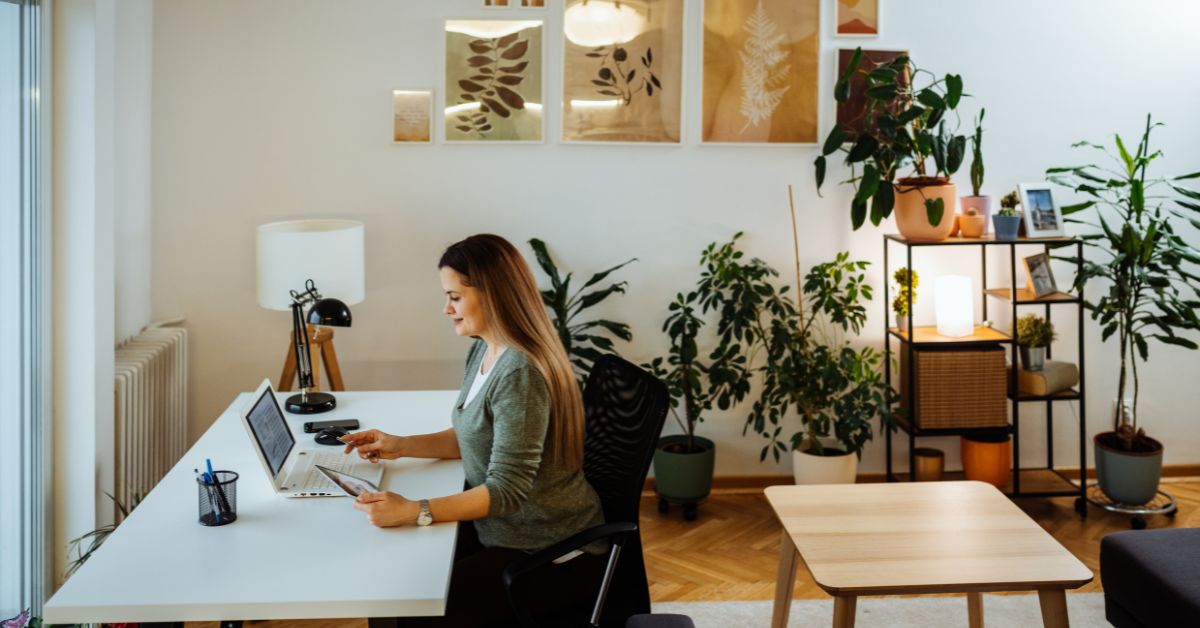
Brought to you by Luxury Flooring:
Working from home definitely has its perks, but it also comes with its own set of challenges. The biggest? Staying focused and productive when the sofa and the fridge are just a few steps away.
That’s where a well-designed home office makes all the difference. It’s not just about cramming a desk into a spare corner. It’s about creating a space that boosts motivation, supports mental focus, and actually makes working feel… dare it be said… enjoyable.
Start With the Right Spot
Choosing the perfect location for a home office is half the battle. Natural light is an absolute game-changer as it helps improve mood, reduce eye strain, and even makes video calls look less like a horror film audition.
If there’s a spare bedroom, box room, or even a sunny spot on the landing, that’s a great place to start. For those who don’t have a full room to spare, clever furniture placement, shelving or a room divider can help carve out a “zone” that feels separate from the rest of the home.
And don’t overlook the flooring! It sets the foundation for the whole space. Hard flooring like engineered wood, laminate, or LVT is a smart choice for a home office. It’s easy to clean, durable under wheeled chairs, and creates a sleek, professional feel.
Let Some Light In
Natural daylight is top of the list, but it’s not the whole story. A layered lighting setup is key for creating a productive, comfortable atmosphere throughout the day.
Think of it as a mix of overhead lighting for general brightness and task lighting like a stylish desk lamp to focus on paperwork with some ambient lighting for those darker evenings.
Bonus points for warm-toned bulbs that mimic natural daylight. It helps with focus, and it’s far less harsh than cold white light.
Choose Furniture That Feels Good
No one does their best work hunched over a kitchen stool. Investing in the right furniture isn’t about being flashy: it’s about function and comfort.
Start with a proper desk, or a sturdy table at the very least, and an ergonomic chair that supports good posture. There’s nothing motivational about back pain.
Standing desks or adjustable converters are also worth considering, especially for those who find sitting all day zaps their energy. The key is movement and flexibility: keeping the body happy keeps the brain switched on.
Bring in Your Personality
A motivational workspace should feel like you – not a corporate cubicle. That doesn’t mean covering every inch in novelty mugs and photos, but it does mean adding personal touches that bring a little joy.
A bold print or art piece can make a statement or even a pinboard or gallery wall with favorite quotes, postcards or mementoes to inspire you. Plants are great for making a space feel more alive, while scented candles or a diffuser can help create a calming background fragrance
These details might seem small, but they can shift the whole energy of the space. When it feels inspiring, it’s easier to stay on track.
Think Storage and Banish Clutter
Let’s face it, clutter is the sworn enemy of productivity. It’s distracting, frustrating, and can turn a calm space into chaos faster than a Monday morning inbox.
Smart storage doesn’t have to mean bulky filing cabinets. Sleek floating shelves, under-desk drawers, or even woven baskets can do the job while still looking stylish. The trick is to keep daily essentials close by, while hiding away anything that doesn’t serve a purpose.
A clear desk = a clear mind.
Add a Splash of Color
Color has a huge influence on mood and motivation. While everyone’s preferences are different, some shades are especially great for boosting focus and creativity.
Blues and greens are calming and great for concentration, while yellows and oranges spark energy and positivity. Soft neutrals then create a minimalist, tidy feel.
Even just painting one accent wall or adding colorful accessories can shift the mood of the room in the right direction.
Finish With a ‘Clock-Out’ Cue
One of the trickiest parts of working from home? Knowing when to switch off. Without a commute to bookend the day, it’s easy to fall into the trap of “just one more email” at 9pm.
Designing a clear end-of-day routine helps signal that work is done and it’s time to relax. Think about a simple motion like turning off the desk lamp, closing the laptop, or even covering the workspace with a curtain or screen.
Bonus tip: keep work tech out of the bedroom if possible. Bedrooms should be for rest, not spreadsheets!
Leave a Reply